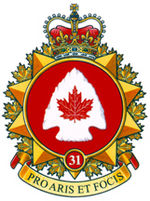| |||||
|---|---|---|---|---|---|
 Brigade group badge | |||||
| Active |
| ||||
| Country | Canada | ||||
| Branch | Canadian Army | ||||
| Type | Headquarters | ||||
| Part of | 4th Canadian Division | ||||
| Garrison/HQ | Wolseley Barracks, London, Ontario | ||||
| Motto(s) | Pro aris et focis (Latin for 'for hearth and home') [1] | ||||
| Website | www | ||||
| Insignia | |||||
| NATO Map Symbol [2] |
| ||||
31 Canadian Brigade Group (31 CBG; French: 31e Groupe-brigade du Canada) is part of the 4th Canadian Division, under the Canadian Army. It encompasses the southwestern portion of Ontario, and is headquartered in London, Ontario. The 31 CBG area of responsibility stretches from Hamilton to Windsor. The brigade has approximately 2,400 soldiers. Colonel Blair Ashford, CD is Commander of 31 Canadian Brigade Group. The brigade sergeant-major is Chief Warrant Officer Tracy Sharp, CD [3]

